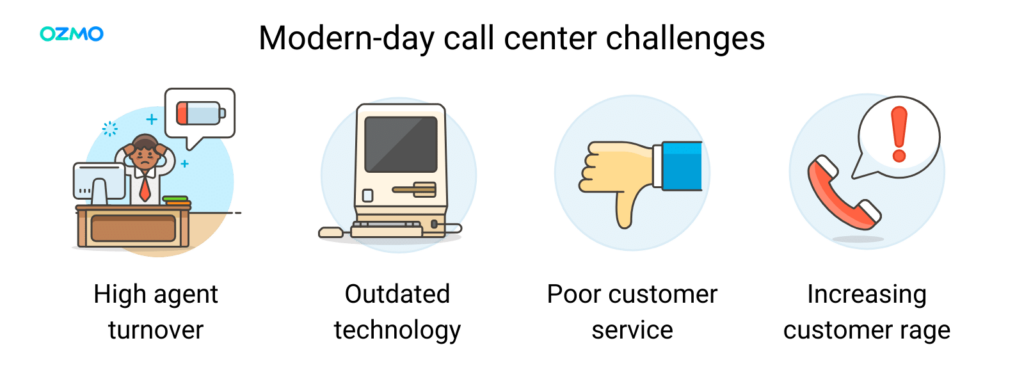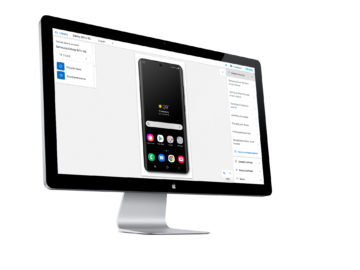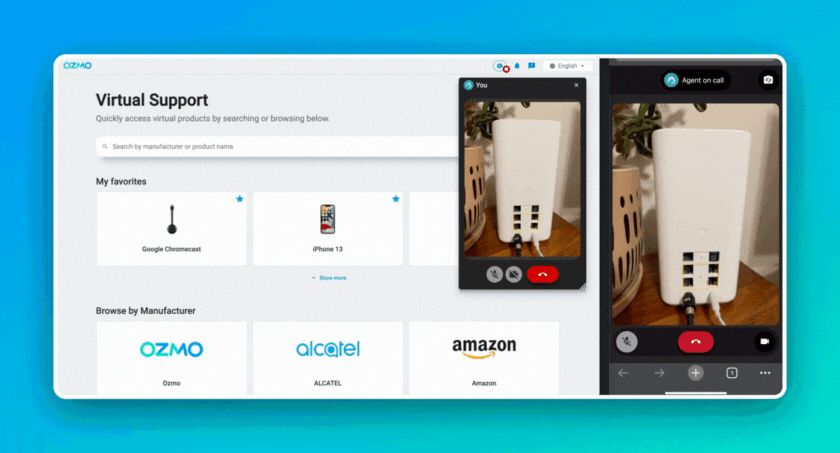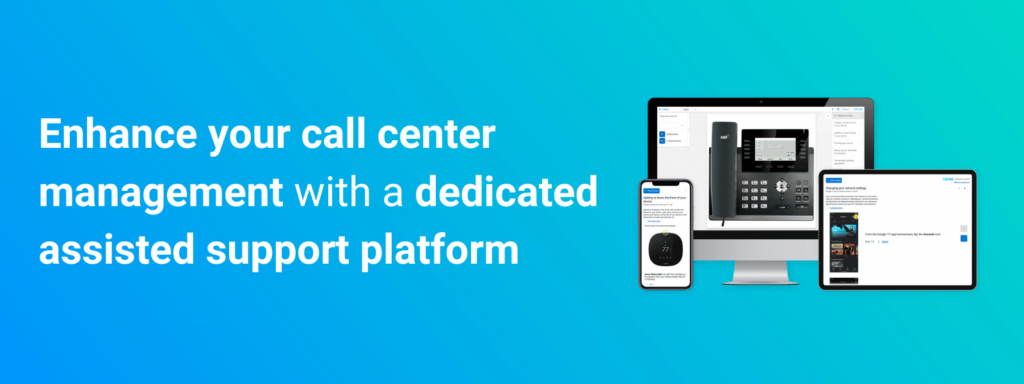The ultimate guide to call center management (tips and best practices)
How to increase customer satisfaction, reduce agent turnover and provide high-quality tech support
Empower your agents, increase NPS and stand out from your competitors today.
Table of contents
- Call centers as revenue drivers
- Current call center management challenges
- Call center management best practices
- How to develop a customer service strategy for your call center
- How effective call center management is vital to business success
Your call center is the key to running a successful broadband or telecom business. When your call center delivers quality customer service, it can help your business maintain a loyal customer base and increase your bottom line.
Yet many call centers aren’t managed in a way that allows companies to reap these benefits. Many customers don’t view their telecom or broadband provider favorably.
According to the American Customer Satisfaction Index (ACSI), customers only hate broadband and telecom providers slightly less than gas stations. Why? Often, it boils down to poor call center management.
For example, despite numerous efforts to contact her broadband provider, a British woman says the company didn’t respond to her inquiries, resulting in 18 days without internet access. Another man waited on hold for 14 hours to speak to an agent at his telecom provider’s call center.
While these examples may seem extreme, the importance of effective call center management can’t be overstated. It’s estimated that businesses lose between $75 million and $1.6 trillion annually due to poor customer service.
But in the age of advanced technology such as AI, do you need to focus on improving a call center that employs people? Yes, and here’s why:
- Almost three-fourths of customers prefer speaking with a human agent
- 88% of customers still use the phone to interact with businesses
- 71% of customers prefer to talk to a human for tech support
- 77% of customers say that humans are still a vital part of a good service experience
- Nearly half of customers in the last year left a business due to poor customer service
- 58% of customers say customer service is key when deciding whether to continue doing business with a brand.
While tools like chatbots can help improve agent performance, technology can’t completely replace humans. Customers still want a customer service experience with a human touch. At the same time, expectations are higher than ever, with two-thirds of customers expecting a response to a support request within five minutes.
All of this may leave you wondering how to effectively manage a call center that delivers fast service while maintaining that critical human element customers crave. That’s why we’ve created this guide.
Call centers as revenue drivers
A well-managed call center can be a powerful way to improve your company’s bottom line. The quality of your customer service is a crucial factor when customers decide whether or not to continue doing business with you.
Additionally, many customers believe human agents are integral to a good service experience. Research shows that 73% of customers stay with a company if they have friendly customer service agents.
If your agents can provide the positive, human-centered experience customers crave, customer retention increases, and, in turn, so do your profits. A five percent increase in customer retention can raise profits by as much as 95%. A well-managed call center provides new potential revenue opportunities for your business to tap into.
Current call center challenges
To say that call center management is difficult would be an understatement. Several roadblocks can hinder your call center’s performance. Below are a few common challenges faced by broadband and telecom call centers.

High agent turnover
Turnover rates for call centers continue to be high. The average turnover rate for call center agents is 45%, astronomically higher than the overall U.S. average of 3.8%.
Numerous contributing factors lead to high agent attrition. For example, many agents may leave their jobs due to a lack of flexible work opportunities, customer hostility and lack of recognition. This combination of factors can lead to employee disengagement and burnout.
Outdated technology
Outdated technology can hinder your call center's efficiency. For example, many call centers supply their agents with a library of physical devices, such as tablets or smartphones.
However, when you consider that Google and Apple release multiple software updates a year, you realize that those devices can quickly become outdated. This makes it difficult for agents to provide accurate tech support for customers, which can hinder job performance and increase the risk of burnout.
Poor customer service experiences
High agent turnover and outdated technology can negatively impact the customer experience. Some examples of poor customer service include increased call center wait times, being transferred to multiple agents, or having to call back because a tech issue was not resolved.
Creating a better customer service experience is critical to the success of your broadband or telecom company. 96% of customers leave a company after one bad support experience. As more companies enter the broadband and telecom markets, it’s increasingly easy for your customers to switch to a competitor if they don’t get the support they need.
Increasing customer rage
According to the National Customer Rage survey, customers are angrier than ever, with two out of three reporting feeling rage due to a service issue. Additionally, the survey found that 43% of customers have admitted to yelling at call center agents.
The increasing rage is due to various reasons, from rising customer expectations to low-quality customer service. This can have devastating consequences for your business. The survey found that collectively, U.S. companies risk $887 billion due to poor customer service. Effective call center management is vital for keeping customers happy and preventing a decrease in profitability.
Call center management best practices
To say that managing a call center is easy would be putting it mildly. You need to ensure you’re balancing the needs of employees while meeting key business objectives and delivering quality customer service. Below, we go over a few best practices to help you juggle the many demands of running a thriving call center.
Focus on your agent onboarding program
Creating a successful agent onboarding program is a critical first step for effective call center management. When done right, it can be a powerful tool for combatting agent turnover. Research shows that employees who have a poor onboarding experience are twice as likely to look for a new job.
So, how can you create an onboarding program that makes agents want to stay? It starts by setting clear goals and expectations. To do this, you may want to create a 30-60-90 day plan for each new hire.
Also, ensure that all training materials are up to date so your new agents can access accurate information when assisting customers. You’ll also want to provide clear feedback. Let agents know what they’re doing well and provide actionable recommendations for any areas where they need to improve.
Equip agents with the right technology
Provide agents with the right tools to help them perform their jobs effectively. Here are a few examples of how technology can improve your call center’s performance.
Leverage live video support
The numbers don’t lie: live video support is a powerful tool to improve the customer experience and stand out from competitors. Nine out of 10 customers say live video creates a positive customer support experience.
Live video support technology improves communication between customers and call center agents. As a result, agents can provide more accurate tech support and resolve tech issues much more quickly.
Using remote video support effectively allows agents to provide a more personalized customer service experience while reducing expensive truck rolls. This can lead to increased customer loyalty and improve your company’s bottom line.
Use virtual devices or emulators
Virtualization, or virtual emulators, can significantly improve the efficiency of your call center and reduce unnecessary business costs. Virtual devices mimic the same functionality as physical ones.
However, unlike a library of physical devices, virtual emulators dynamically update, ensuring your agents have the most accurate information possible to guide customers through troubleshooting. They can also switch between multiple versions of the same device (such as a Google Pixel 8).
Additionally, your call center doesn’t have to maintain or repair virtual devices, which can reduce overall expenses. Leveraging virtualization can be a cost-effective way to ensure accurate tech support and allows your agents to access the tools they need from the office or home.
Alleviate high call volume with chatbots
Technology such as chatbots can be an effective tool for augmenting agent performance. One of the main benefits of using chatbots is that they reduce the caseload for agents by addressing customers' frequently asked questions. For example, where they go to pay their bill or provide customers with your closest store locations.
This frees agents to take on more complex service requests requiring human expertise. Additionally, as chatbots successfully field these simple requests, call volume decreases, which in turn decreases business expenses.
As an added bonus, using chatbots can be a budget-friendly way to scale your tech support. This can be especially critical for regional service providers wanting to stay competitive against bigger, nationwide carriers with more staff.
Monitor call center key metrics
You need to track key call center metrics to understand how yours is performing and identify opportunities for improvement. Below are a few examples of call center metrics you may want to consider monitoring:
Average handle time (AHT)
Average handle time measures the length of an interaction between your call center agents and a customer. To calculate average handle time, you need to add total talk time, hold time and follow-up time, and divide that number by the total number of calls.
Generally, the lower the average handle time, the better. Your customers are busy, and time is their most precious commodity. The faster they can get back to their streaming, gaming or work, the happier they’ll be.
First call resolution (FCR)
First call resolution rate refers to the ability of your agents to resolve a customer service request the first time a customer contacts your company. Focusing on first call resolution is critical for improving the customer experience and loyalty. It also has implications for agent happiness.
Improving first call resolution can also provide your business with significant cost savings. For example, Verizon saved millions per call center annually and increased customer satisfaction by enhancing its first call resolution.

Exceed customer expectations
With unmatched call center support
Learn about how Verizon saved millions per call center with a comprehensive assisted support platform.
Net promoter score (NPS)
Net promoter score measures customer satisfaction with your service and the likelihood that they’ll recommend you to someone else. Generally, you should review your net promoter score every quarter to understand how customers feel about your business.
By focusing on your net promoter score, you can increase customer satisfaction and turn customers into brand evangelists. This is especially critical in our digital age, where an online customer review can reverberate throughout social media and the rest of the online world.
Customer retention rate
Your customer retention rate refers to your company's ability to retain customers after acquiring them. Keeping current customers is much cheaper than constantly looking for new ones. Research shows that acquiring new customers can cost up to five times more than retaining your current customer base.
So, what's a good customer retention rate? Generally, the telecom industry's ideal customer retention rate is 78%. For IT and broadband, the industry average is 77%. If your company's numbers aren't where you'd like them to be, rest assured that there are several customer retention strategies you can implement to improve this particular metric.
Customer churn rate
Customer churn rate refers to the percentage of customers who stop doing business with you within a given period. While a customer churn rate of 0 is ideal, the average for broadband and wireless services is 21%.
When it comes to reducing customer churn rate, you might be tempted to focus on things like price. However, many of the causes of customer churn are psychological in nature. Research shows that a customer’s negative emotions, such as sadness or rage, strongly correlate to churn. For this reason, your overall customer service strategy needs to keep customers’ emotions front of mind.
Focus on increasing employee engagement
Employee engagement is key to improving the customer experience and good call center management. The average agent turnover rate is 45%, much higher than turnover rates for other occupations. However, employee engagement isn’t just about creating a better employee experience. The more engaged your employees are, the higher the quality of your customer service.
For example, engaged employees tend to be more productive and better at resolving customer service issues. This can lead to higher agent net promoter scores and improve first call resolution rates.
As a result, these employees can improve your company’s profitability and customer loyalty. One study found that companies with engaged employees have a customer retention rate 233% higher than those who don’t.
How to develop a customer service strategy for your call center
Your call center strategy is your map to success. With so much at stake, it’s important not to improvise. Here are a few tips to help you start building an effective call center strategy.
1. Set clear goals
Setting clear goals is the first step to developing an effective customer service strategy. You’ll want to use a S.M.A.R.T. goal approach. S.M.A.R.T. stands for specific, measurable, achievable, relevant and time-bound. This approach ensures the entire team is aligned on what needs to be done and when.
As a result, your team can better gauge how close they are to reaching these goals and identify any potential opportunities or roadblocks. The key to setting effective S.M.A.R.T. goals is making them specific regarding what you want to achieve.
Don’t set vague, lofty goals such as “improve our call center performance.” Drill down into what that looks like. Additionally, you want to ensure that your goals are realistic for you and your team to strive for. Ensure that these goals align with overall company objectives and set a deadline by which you want to achieve them.
2. Decide which metrics to track
Once you’ve set your goals, decide which metrics, or key performance indicators, best align with them. Choosing the right metrics is crucial to ensuring you and your team are making progress.
How do you know what the right metrics are? The right metrics for your business depend on what you’re trying to achieve.
For example, if your goal is to increase customer satisfaction by the end of the third quarter, you might monitor metrics such as customer churn rate or net promoter score. Reflect upon your specific goals to determine the appropriate metrics for evaluating the efficacy of your overall strategy.
3. Consider offering hybrid work options to agents
A hybrid customer service strategy can be a great way to reduce turnover and improve employee engagement. Research shows that employees with a hybrid schedule are happier and more satisfied with their work. They also tend to have the highest engagement rates versus their fully in-office or remote peers.
Employees who are happy and engaged are more likely to stay. Hybrid work can also help reduce unnecessary costs for your call center. A report by Cisco found that the company saved over $500 million by switching to a hybrid work model. The bottom line? Hybrid work is a win-win for your company, your customers and your call center agents.
4. Evaluate your tech stack
What technology resources are currently available to your team? Are they relying on libraries of physical devices or using virtual emulators?
Knowing the answers to these questions helps you understand what resources are available and identify any critical gaps. The right technology can help your agents work more quickly and effectively. This is critical when you consider that customer demands are higher than ever. Use technology not to replace your agents but to help them do their jobs better.
5. Provide agents with access to a central knowledge base
Many call center agents struggle to answer customer service questions due to outdated training manuals. This forces agents to turn to internet forums, which aren’t always reliable sources of information. As a result, average handle time, customer rage, and churn rates may increase.
To help agents improve performance, ensure that all training materials and learning resources are current. If you don’t have the time to manually update these resources periodically, consider using a digital knowledge base that updates dynamically.
Investing in your agents’ knowledge base helps them improve their performance and customer satisfaction. When Twigby implemented digital learning resources for agents, the business saw a 15% increase in positive customer ratings, achieving an average of 4.5/5 star reviews on Google. Here’s an example of one of the many positive reviews Twigby received:
6. Collect and act on customer feedback
If you're trying to identify areas for improvement within your call center, don't neglect customers' voices. Customer feedback is a powerful tool to understand where your call center shines and where you can make improvements.
For example, maybe your customers would prefer omnichannel customer service so that they can reach out to agents via SMS or email instead of just over the phone. Perhaps in a survey, they're reporting that it takes multiple phone calls to resolve an issue with their smart home device.
This customer feedback can give you critical insights for improving the management of your call center and inspire you to investigate further. For example, if customers are having to call multiple times because a tech issue remains unresolved, why? Do agents need better training? Collecting and acting on customer feedback is critical to fine-tuning your strategy.
Effective call center management is vital to business success
Your call center’s performance is critical in helping your company meet key business objectives. Modern business challenges like high call center agent attrition or customer churn can be reduced using effective call center management.
The quality of your customer service is a critical factor in your customers’ decisions to stay or stop doing business with your company. You want to ensure a streamlined service experience that makes it difficult for them to walk away. Follow the tips in our guide to successfully manage your call center and stand out from the competition.
Looking to empower your agents with the tools they need to succeed? Check out Ozmo for Agents.


